My intention is to present a discussion of particular problems by which exchanges among music theorists have seemed to me inhibited in the past several decades. What I propose is a critical commentary, not in reproof but in advocacy of certain principles of community. The Society for Music Theory is doing well under prudent leadership and is set on a deliberate course toward improving its operations in important ways. In that fortuitous circumstance and in the broadest possible perspective, I wish to regard a number of apparent impediments to effective professional communication.
In an impulse happily aborted I had considered titling this address "The Professional Colloquy: Is It All Rite?" That is to say that I felt that some of our discourse falls short because of certain ritualistic tendencies or prejudicial dispositions, and for other reasons I shall try to suggest. I do not doubt that my particular list of concerns would be qualified by other observers nor that exception will be taken to points I shall make. However that may be, I think you will find that affirmative feelings of forthcoming, already apparent trends and possibilities emerge in the course of this overview.
Some of these thoughts have been stewing for years and surfaced at once when I was invited to make a formal address to the Society. Others are pursuant to the work of the Society's Committee on Program Design, whose report is now before the Executive Board, and which was set up two years ago to challenge standing assumptions about conferences and their stereotypical sessions: the paper, the respondent, the questions and comments, an often problematic environment, competing attractions, and the often futile effort to hear and assimilate in conditions less than conducive to effective change. Whatever these difficulties, we affirm here a common belief in the importance of formal organization for the implementation of shared goals. One is encouraged in the intuition that the Society's character and human composition are not of a kind to suggest inertial, uncritical submission to established patterns. This augurs well for our progress, for the resourceful development of alternative procedures to serve particular ends, and for our capacity for leadership among fraternal organizations. Perhaps a most important recommendation of the Committee on Program Design is that the review of programing continue at intervals, or even indefinitely, by creation of a standing committee for this purpose.
We assume that the professional colloquy has salutary effect in a scholarly discipline, and that conferences are not just for finding and filling jobs and for academic advancement. Such exchanges may well have unusual significance in music theory. I do not wish to exaggerate this subsidiary point nor to be misunderstood in it; but it seems to me that, for example, a historical musicologist functions more easily than his colleague in music theory with less than comprehensive familiarity with studies throughout his discipline, apart from common concerns with research method and opportunity, and with the broad perspectives of historical continuity.
What I have in mind is music theory as a totality of endeavor involving many kinds of inquiry directed toward certain fundamental issues, a holistic effort comprised of interdependent movements of truly encompassing purposes. The theorist must function, apart from his place in any linear continuity, in a way that allows him a sense of presence and locus in an intellectual search in which an important issue such as stylistic evolution is subsidiary to a necessary depth of explorative penetration of form and experience. Because of extreme differences of method, music theory is probably even more prone to polemic than a historical discipline, so that an effective colloquy is especially critical.
In that colloquy we rely on many arenas and media, including informal exchanges, perhaps the most valuable of all, in individual, largely academic communities. Here one must acknowledge that informal dialogue is often impaired by a lack of rational order, by the too casual conveyance of views. Nevertheless we value informal discussion as a means of honing ideas in preliminary exploration and testing, in an atmosphere of spontaneous interaction.
Then there is the relatively structured institutional colloquium. I am not certain how universal this practice is, but the two universities with which I have been affiliated in the past 23 years have had it. At the University of British Columbia it is a frequent Friday afternoon activity throughout the academic year, attended by interested faculty and graduate students in musicology and music theory, featuring papers-cum-discussion presented by resident individuals, by invited guests, or by scholars passing through. My view is one of conviction as to the value and significance of this activity, often a forum for preliminary presentation of something slated for larger circumstances.
As we learned in the years in which the Society for Music Theory was in prospect, there are many regional activities and symposia—some of regular occurrence and relatively fixed organizational stability, others occasional. Such activities tend to exist under the aegis of academic departments.
Until recently the Journal of Music Theory and Perspectives of New Music have served conspicuously in a field severely manqué; suddenly we have Spectrum and apparently-flourishing student-motivated periodicals emanating from Michigan and Indiana. We address one another in books, when we can publish them in a largely commercial industry, while a special problem is the relative dearth of opportunity for publishing monographs. (The Society is looking into possibilities for a supporting role in bringing out monographs of significant content.)
With the emergence of the Society for Music Theory, as in the years preceding its inception, we have national conferences, the grand medium, and a greatly vivified professional and scholarly milieu. By no means was such a national instrumentality a matter of unequivocal conviction in the Society's genesis, a time of indecision and traumatic suspicion in the prospect of what is now a fact of secure existence. A sign of health is the Society's rapid growth in a few years; another I have noted is its determination, perhaps alone among major learned organizations, to review and circumspectly overhaul, as necessary, the procedures by which its conferences are planned and conducted. The Society has also responded positively to the need of many members for sessions and papers on pedagogical issues, a need expressed in a context of some irony, since teaching, more than any other activity, is the common denominator by which we are associated.
Even with this abruptly broad range of opportunity, most would accept—I believe—the thesis of a variously problematic status quo, while embracing the intent to encourage ameliorated conditions of discourse.
My first point at issue is that of a persistent disseverance in the professional world of which music theorists are a part. Many will recall that this was a matter of anguish in the Society's prenatal period, when it was argued by an important minority that a further splintering in the professional community would impair and perhaps preclude the kinds of interaction by which coalescent development is fostered in musical scholarship. At the same time one stimulus toward establishing the Society was a feeling that the discipline of music theory has been poorly understood in other domains of music research, including those of ethnomusicology and historical musicology. Theorists had for many years borne a burden of uncertain place in existing societies of which they were restless constituents, and of patronizing characterization as harmony and counterpoint teachers not quite into, or up to, serious scholarly effort. To be more candid, let us acknowledge that we have often returned deprecation in kind, feeling that while our colleagues dug around for facts about style and historical practice, we were in pursuit of Olympian truths, we the scientists and philosophers.
I am not saying that the birth of the Society is accountable to such base emotive tendencies; many very compelling reasons were articulated in the careful, deliberate process of its evolution. We are where we are. If today the separateness of societies is to be effectively circumvented we shall have to share and better understand one another's work, while cultivating deliberate common enterprise of formal kinds, especially between the American Musicological Society and the Society for Music Theory. Jointly conducted sessions in such an area as the history of music theory are an obvious way to begin. Individuals who actively share the methods and concerns of the two scholarly groups can play a special role in the kind of collaborative effort needed to bring us together, now and then, in a colloquy engaging variously directed issues of joint concern. Organizations, in newly defined interrelations, will have to resist any notions of a heliocentric professional universe in which they compete for the position of "best" arbiter of authenticity.
A second concern is that we theorists often tend to work in strange isolation from music. I suppose that this observation is almost platitudinous, that no one would deny that we are impoverished, and at times our work rendered suspect, in the too common absence of music in our exchanges. I do not refer necessarily to concerts, which can be increasingly tiresome formalities; rather I am thinking of illustration, in the juxtaposition of comment and subject, and in documentation of claims of relevance.
In view of the difficulties to be confronted, it is not surprising that we do not consistently give our thinking about musical structure that crucial test, in which to be sure there are not final answers, as we quickly accept in any effort to apply theoretical conclusions to musical realizations. Analysis can tell us many kinds of things, such as about style, or about finely wrought details of creative craft, but interesting analytical insights also suggest, however speculatively, shape and direction in the ultimate auditory experience which the theoretical construct figures, or disfigures. The kind of approach represented, for example, by last year's paper on the Schoenberg violin and piano fantasy is recognized more in breach than in observance. As musician-theorists we should seek to show concretely the applications of pertinent ideas to musical experience and behavior; commonly, we do not take the trouble to do that.
My third point is related; it is the overt denial, in many recent and current educational circumstances, of the pursuit of fundamental musicianship and literacy, a negative tendency probably past its nadir but whose effects are yet discernible. The nonmusician-composer is, I like to think, a vanishing breed, after a time in which musical creativity has too often been an exercise of artful stratagem, even at times with questionable sobriety of intent, in which the control of a richly, musically imagining mind over pen has not always been evident. If such a question is beyond the present concerns, that of the often strident nonmusician-theorist is not. (In my usage a musician is one who can carry a tune, even by Bartók or Webern.)
It seems to me probable that a significant factor in condescension toward training in the skills of musicianship, an attitude fostered no doubt by nonmusician-theorists in a circular process of destructive result, can be seen in the understandable assertion of identity by music theory in recent times, a phenomenon to which I have referred. By this I mean that in a perspective of long preoccupation with sight singing and ear training in first- and second-year college courses, music theorists have sought to proclaim a valid identity in negative as well as positive ways, a quandary now considerably resolved in new professional alignments. At any rate the tendency which I am deploring is perhaps now merely residual, and if there are those who would argue that aspiring performers, composers, teachers, and scholars can do without the faculties of strict awareness of heard and contemplated musical relations, we do not often hear from them.
So there is reason to think that we are swinging back to basics in higher music education, and in the values we induce. If development of the skills of musical discrimination has been disparaged, we can now detect signs of renewed appreciation of insightful and accurate hearing and conception as relevant to any claim of legitimacy in practicing—or thinking about—music.
A fourth problem I shall characterize as "Babelism"—a confusion emanating from the multilingual state of our community. At times this derives from the conventions of other disciplines. But we have some personal languages too, and something less than consistent fidelity of patient definition. It is in this Babelist circumstance that some of us wishfully engage in monologue.
One of the casualties of efforts to cut this paper to manageable size was a selection of pertinent examples culled from recent publications, including one of my own, in a rather breezy, almost random scan. The citations I had in mind scarcely began to explore the gamut of realities, not to mention possibilities. Such references often occur within expository contexts which are clear—even models of clarity—and would be noted not necessarily in stricture, rather in illustration of the diversity and difficulty of system and lexicon by which we are confronted.
It is not unreasonable to suppose that the greater part of what is published in the name of music theory ought to be assimilable by most of, say, the members of the Society, even while highly specialized presentations for a limited readership are encouraged, in balance, in the interest of advancing new modes of inquiry and in favor of the free interflow of ideas.
While the most powerful insights of theorists have sprung from intuitive responses to music profoundly sensed, theoretical work in our time incorporates many formal and formalistic methods, often of other disciplines, perhaps inducing important kinds of understanding unattainable in the documented yet unproven assertion, ipse dixit, by which we have traditionally sought, in penetrating insights as musicians, to deal with a bewildering network of relations in pieces, and between structures and experience. It seems to me unclear that such formulations, however rigorous, treat the structural network beyond its superficial aspects. But that may be my particular confinement, and the problematic Babelism of much of our intercommunication is not a subject for combat, but only for indulgent awareness. The introduction into our conferences of special seminars is one answer; instructional clarity in the published media, to the extent it is feasible, is another.
A further problem is the tendency of obscurantism, a term I am using in the sense of obfuscation in gratuitous complexity and in the meretricious guise of conundrum. The adoration of complexity, or apparent complexity, is manifest in the collateral tendency of disparagement of relatively simple approaches in which the obvious goes unacknowledged and perhaps also unrecognized. One cannot, after all, be caught in an utterance devoid of elaborate schema portraying supposed profoundly abstruse issues, whatever the judgment or intuition of significance.
We need to be reminded that validity is not to be inferred from intricacies of formulation, and that attention to the obvious circumstances of structure and form often conduces to important elements of understanding. To question obscurantist tendencies is not to disclaim the necessity for the serious probing of issues of great subtlety, and in analysis, of relatively recondite factors of a kind we think pertinent to, and possibly appreciable in, underlying structures in interesting music.
My sixth point is, in a way, the obverse of the coin of obfuscation: I shall call it Philistinism, the unwillingness to be challenged by unfamiliar modes of thought and study, often taking the form of overt contempt in a disposition of saturnine resistance and withdrawal. I suspect that some of our colleagues who observe these conferences by staying at home are acting in tacit rebellion against the effort of participation, in an ultimate negativism. It must be obvious that prejudicial rejection in any direction has devastating effect, representing a denial of the intellectual striving to which we are all ostensibly committed.
In citing this as part of the syndrome of inhibition by which professional dialogue is afflicted, I wish to acknowledge explicitly the pernicious consequences of any preemptive acceptance of the status quo. If we are unwilling to think anew, to submit to evolving ways of thought and study, and to entertain unaccustomed (even highly individual) ideas, we stifle an aspect of growth in understanding which must parallel that of the continuing exploitation of proven methods. Philistinism, the desperate adherence to what is, and to what is comfortable, is as deadly as it is widespread.
This malaise, which I have called Philistinism, I think of as willful denial. There is yet another kind of subversive manifestation, baleful in its effect, for which I shall use the term Harlequinism, a capriciously cryptic behavior or reticence, whose psychological motivations I should not seek to characterize, but which appears as a kind of gleeful obfuscation, yet usually, I believe, of earnest intent and import.
In the presence of mummery the attentive and conscientious reader or listener asks whether he has encountered art and not mere artifice. One would not hope, after all, to reduce a provocative work of poetry to naked direct statement.
For myself, I cannot deny that I have occasionally been moved by Harlequinist performance, even in a way I might not have been in a more direct medium. But often I feel irritated at having to peer darkly through a veiled surface, in an effort to assimilate thoughts and feelings whose protagonist—I conclude—is engaged in an exercise of ambivalent purpose. I cannot escape the sentiment that Harlequinism can be at times a reaction of intimidation (or cynicism) to the ponderous responsibility of rational communication; or on occasion willfully—even perversely—evasive; or . . . perhaps . . . it is at times motivated by true poetic impulses of which we can be expected to be patiently indulgent.
My eighth of ten references is to faddist enticements to which we can be subject. A perspective can be set if one thinks of the blandishments by which composers—as votaries on this or that bandwagon—have often been misled. During my years as a student and younger academic, to write music without recourse to serialism, and perhaps antithetically to procedures of indeterminacy (to cite two such blandishments), was almost unthinkable, especially for younger artists seeking acceptance. Only now, but for some persistent vestigial streams, is musical creativity squirming free in an atmosphere in which heretofore dominant ideologies, if they have credence, assume measured significance in a balance conducive to individual expressive capability. Reactions to orthodoxy are of course often apostatic, and destructive, as we can see today in the lack of discipline in some gifted young composers. But I believe that a binding, blinding orthodoxy, embraced without question, is yet more destructive. I have only to think of direct personal dilemmas and of many colleagues of a generation ago of whom it could be foreseen that this or that faddism would emerge on schedule, following a predictable lag, the real truth glimmering only intermittently in the mists of confused purpose.
We theorists, too, have fallen into and led our students into the snares of reigning, strident practices, embraced without conviction or full understanding. We are vulnerable to a degree not characteristic of the somewhat more objective work of music historians. I can recall graduate students who have, under such insidious stress, incorporated irrelevant, inept gestures of obedience into incompatible contexts in the inarticulate belief that submission to a reigning currency would somehow endow a work with respectability.
Each of us is a particular constellation of attributes deriving from particular influences of education and experience; we need to have the daring to act truthfully, declining what happens to be in where we are not persuaded of usefulness and validity. Perhaps the mark of the educated professional, as distinct from the merely schooled, is precisely the capacity for individual assertion, however heterodox, reflecting insight emanating from very particular gifts, experience, and conviction, and often requiring the power of deliberate dissent.
As a responsible teacher, at the same time, one guards against Philistinist attitudes, insisting that education include deep penetration into bodies of knowledge and practice which are our particular legacy as theorists, or which flow about us in our time, to the extent human limitations allow, and consistent with conviction.
My next-to-final point, which includes some parenthetical references to ideas about Bach, concerns our occasional myopic vision: an unwillingness to see through another's eyes, to hear through another's ears. The theorist who does only one thing is especially prone to this. Of course, it can involve prejudices I have mentioned; but I am thinking of a sometimes pervasive disposition of intolerance toward everything lying beyond immediate preoccupations of method and philosophy, where the primary impulse vis-à-vis the work of others is that of confutation.
It would be foolish to imply that everything warrants serious penetration, much less acceptance; but anything like the comprehensive understanding of a musical phenomenon is conceivable only as we admit many kinds of hearing, reading, and relentless inquiry, conventional and unconventional.
I wish to turn briefly to the Bach D Minor Prélude, sometimes published as the fifth of Twelve Little Préludes, a straightforward piece, or so it would seem. The prélude has drawn considerable attention from theorists, and I am going to consider views of its rhythmic structure, derived from Yeston, from Cooper and Meyer, and from my own thinking and hearing.
The most evident rhythmic aspect is the regularity of the piece's surface, not unexpected in Bach. What conventional music theory calls the "harmonic rhythm" is also one of much regularity, defining two-measure groupings at least up to measure 19. There is initial regularity, too, in triadic arpeggiation, Yeston's levels A and C, stipulated as "'two middleground strata [which] shape the metrical accentuation of the foreground,"1 the tonic triadic arpeggiation seen as the determinant of triple, as opposed to duple, organization of the measure (Ex. 1).
Ex. 1.
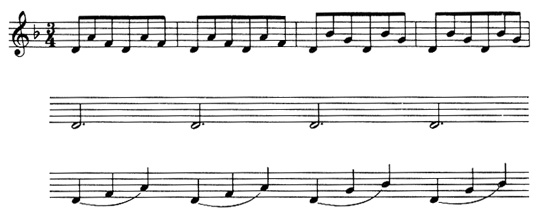
There are, of course, deeper articulations: Yeston's level D is "representative of the overarching motion from the fifth scale step to the upper neighbor. . . ." Presumably this extends to the forthcoming lower neighbor, and the subsequent resolution of both (Ex. 2; the entire piece is reproduced at the conclusion of the article). This larger unit is bound by the explicit pedal point, and in a functional unity to which I wish to refer presently.
Ex. 2

Now there is that nettlesome implication within the bar: a conceivable  meter asserted by two local arpeggiations and a recurrent d (Ex. 3), at twice the frequency of the ascending arpeggiation.
meter asserted by two local arpeggiations and a recurrent d (Ex. 3), at twice the frequency of the ascending arpeggiation.
Ex. 3
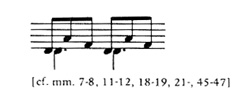
Yeston gives this as his level B, then dismisses it, if I read him correctly, in view of the static d, in favor of his level A (Ex. 1), characterized as active, and to be sure, happily consistent with the meter signature. [Here, my view would differ as to denial of this counteractive implication on the basis of static recurrence, since a fixed recurrence, slower, also underlies the ascending arpeggiation (again, see Ex. 1). Moreover, if  is problematic as of static consequence in measures 1-2, the opposite would apply to 7-8, where it is the
is problematic as of static consequence in measures 1-2, the opposite would apply to 7-8, where it is the  reading that yields pitch recurrence, and at greater frequency (Ex. 4). Thus counteractive implications with the measure remain, I should think, to be reckoned with.]
reading that yields pitch recurrence, and at greater frequency (Ex. 4). Thus counteractive implications with the measure remain, I should think, to be reckoned with.]
Ex. 4
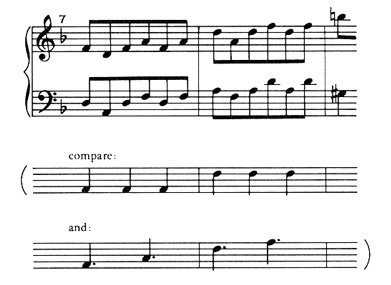
The eighth-note arpeggiation is duplicated over a two-measure span, the augmentation underscored by the preconditioning diminution form, by regularity of occurrence, and by the precedent of hemiola counteraction within the bar. Thus the problematic two-against-three grouping in the measure is pertinent also to the two-measure span (Ex. 5).
Ex. 5.

To return to the prélude's immediate surface is to detect a further rhythmic anomaly. The insistent bass articulation is dominant, but a moment's thought should be given to the a, highest pitch in the immediate context and initiator of a triadic descent. It further denotes the true upper voice (Ex. 6), in a condition of rhythmic displacement, its continuation in b-flat and g at corresponding points in measures 3 and 5, respectively, after which the regularity of temporal succession ceases.
Ex. 6.

I will not go further with this to consider implications of placement in a subordinate voice: f-g-e-f (Ex. 6); yet, any complete rhythmic analysis would deal with actual as distinct from underlying temporal articulations of the elements of these doubling lines. Their manifest rhythms of entry and movement require in execution no particular intervention any more than the quarter-note arpeggiations: they are there as potentially vital percepta in the experience. In an unassuming pattern of regular surface eventfulness, inherent rhythms condition and interact with other potential rhythms in a network of primary and subordinate, anticipative and reverberative, active and counteractive articulations. The performer guides the listening ear; or in a neutral, relatively mechanistic representation, the listener discovers as his comprehension allows rhythmic irregularities that belie the apparent composure of the surface.
Questions of metric grouping as conditioned by accent open a complementary field of inquiry. The characterization of the example as "trochaic" at three levels by Cooper and Meyer2 is given as Ex. 7.
Ex. 7.
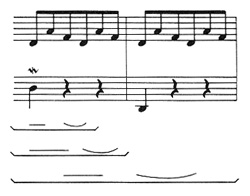
I see no factors that would contravene this interpretation of trochaic grouping, even to the level portrayed, where the criteria of accentual relation are not given. A premise of superior accent in measure 1 as to measure 2 seems quite arguable as to temporal ordering, and in the shape of the ornamented bass with its two-measure descent.
Taking this departure, one's view of metric interpretation as to accent-conditioned grouping might consider also what Edward Cone calls "hypermeasures," levels for which I have used the term "intermensural" meter. In such a view of the entire eight-measure opening unit, I see no reason to think of "accent" other than in relation to measure 1 (as do Cooper and Meyer on a narrower basis), as the first in a relatively neutral series of prolonging articulations. In a comparable "metric" interpretation of the entire prélude (it may, I think, be viewed as a single phrase), measure 9 would have special significance, with its occurrence of the pitch b2 in a strongly dissonant environment, initiating a consistent, very broad step descent in a new registral area (Ex. 8).
Ex. 8.
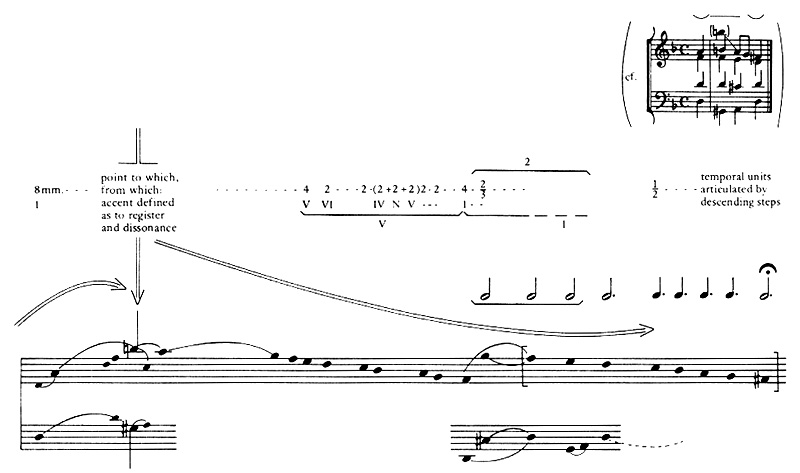
In that view the opening eight measures are seen in a broad dynamic-metric shape, if you will allow me these terms as they are used in my work. The octave shift and resumption of step descent from g2 (measures 42-43) feature accelerated linear succession in dotted quarters, a further counteractive  implication (measures 45-47). All of this is represented as Example 8, which also shows gradual acceleration among units delineated by the descending steps from measure 9 to the end. One might illustrate that rhythm in an unnatural, minimal context of outer voices and harmony stripped of surface activity, with components and expansions in the pacing of linear movement. What is thus portrayed (Ex. 9) is indeed one of the piece's many rhythms—one of its more palpable, I should think, in a structure we have only begun to explore in quoted and contrived examples.
implication (measures 45-47). All of this is represented as Example 8, which also shows gradual acceleration among units delineated by the descending steps from measure 9 to the end. One might illustrate that rhythm in an unnatural, minimal context of outer voices and harmony stripped of surface activity, with components and expansions in the pacing of linear movement. What is thus portrayed (Ex. 9) is indeed one of the piece's many rhythms—one of its more palpable, I should think, in a structure we have only begun to explore in quoted and contrived examples.
Ex. 9.
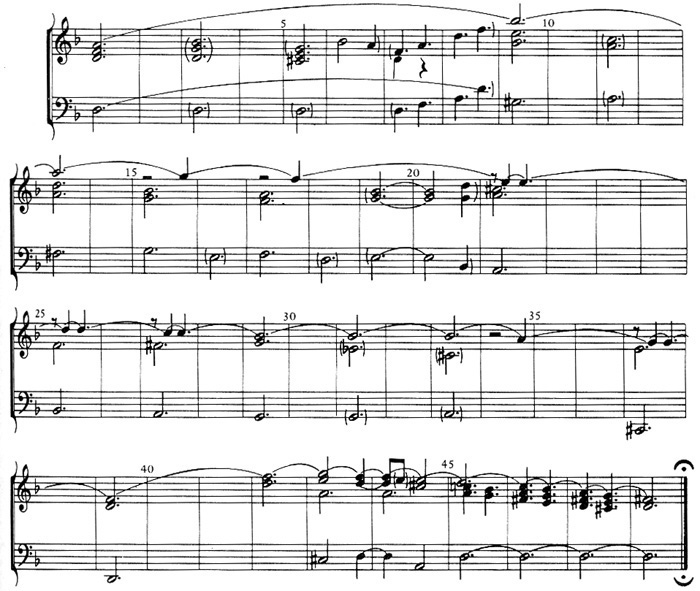
(The rhythm of descending steps, heard very distinctly in Example 9, is, like that of the displaced upper voice, one of actual occurrence, precisely measured.)
I have tried to show a multifarious rhythmic organism requiring various paths of access, each affording some manner of insight, none adequate. Is not the miraculous point of this piece's rhythms precisely that of a deceptively benign surface masking vital, cofunctioning rhythmic currents (some provocatively displaced; some overlying, some underlying; groupings enclosing groupings conditioned by diverse factors—linear, harmonic, textural, registral., accentual)? As to the broad, all-encompassing dynamic-metric order which I infer, I do not think one could adduce a more telling example.
It is almost possible to imagine an "ultimate" experience of this (little) prélude in which the interplay of variously conditioned, divergent middlegrounds is heard and felt within a totally inclusive unity—mine, perhaps, or another. Disparate approaches and findings are essential, not merely admissible, in any effort toward comprehensive understanding. The difficult quest for such fuller understanding brings to my mind the work of a richly productive colleague whose readings, especially of metric functions and relations, often appear deeply at variance with my views of syntax and interpretation. Still, I have never failed to be stimulated by his thinking, and his work has often led me into directions of analysis, and suggested theoretical possibilities I should not otherwise have explored.
My final topic is much simpler to detail, yet overwhelming in its implication: it seems to me a sad probability that we do not really read one another very much. Our journals are largely for office shelves, ideally out of sight where they do not prick the conscience, yet sufficiently in evidence to enhance the professional image. There are significant exceptions to this sweeping observation; and there are, to be sure, times when we have to do better, as when we serve on tenure committees and accept the responsibility for sound evaluation, or when a colleague has published something and expects a comment (a superficial one will usually do nicely).
Perhaps there is something like a surfeit of articles and papers and a need for encouraging and publishing larger works, where theory and concept can be more fully exposed, and which can serve recurrently as sources in teaching, as references—at least in coherent excerpt—for repeated applications of different kinds. And yet those who have published books and monographs are often sadly aware that their names—but not their ideas—are known. On a few occasions I myself have experienced the deep satisfaction of the probing, critical exploration of my work by graduate seminars taught by colleagues in various places; that has had great value for me, as have productive seminars I have chosen to devote to the work of others, not necessarily as instruction but as stimulation toward further effort.
The reasons for our too common neglect of one another are certainly many. We lack time. We lack interest. We are turned off. Important theoretical work requires a lot more than mere reading; and so much beckons to us. This problem is put potently as a general cultural phenomenon by the psychologist Ernest Becker (who in turn quotes Norman Brown) in one of his last works.
One of the reasons, I believe, that knowledge is in a state of useless overproduction is that it is strewn all over the place, spoken in a thousand competitive voices. Its insignificant fragments are magnified all out of proportion, while its major . . . insights lie around begging for attention. There is no throbbing, vital center. Norman O. Brown observed that the great world needs more Eros and less strife, and the intellectual world needs it just as much. There has to be revealed the harmony that unites many different positions, so that 'sterile . . . polemics' can be abated.3
So this is one of our dilemmas. As to the likelihood that we often give up in conditions of stifling inundation, I have no real solution to suggest. The obvious indication—that we publish less—is unfair to much that deserves to be known. In any event it is an indication unlikely to be heeded, yet perhaps to be held in mind as publications proliferate, and as opportunities may arise for wider use of those that are in print and have value.
I trust that these observations, deliberate and earnest, are free of moralizing. I have tried to speak clearly and candidly, choosing to avoid gratuitous, probative attributions, leaving it to my listeners to decide where a shoe may fit, if indeed there is a shoe. No one would contend that all is well in this best of all professional worlds, of which we are often somewhat uneasy denizens, so that if my run-down of specific issues is flawed, the broad message may persist. That message is one of appeal for redirected effort toward a greater catholicity of thought and acceptance, avoidance of the actions and reactions of obscurantism and Philistinism, bold experimentation in conference programing wherever there is reasonable promise, reaffirmation of the necessities of musicianship and musical practice in our work, resistance to highly publicized ideas and methods except where they can be embraced with conviction, abandonment of governing predispositions, and better modes of active alliance with other societies. Whatever understanding we may achieve—and let's face it, we have relatively little at this, our prepubscent stage of professional development—will be the result of the fusive interactions of many currents of coexistent inquiry, directed to a common ultimate purpose. Into the continuing colloquy which we are assured by a healthy Society, we should resolve freely to admit colleagues so far largely anonymous, as we consciously resist the temptation to ascribe special credence, prima facie, to big names of big places and big people. The occasional bedazzlement with names and places, and reflexive rejection of materials of unfamiliar (or apparently unlikely) identity, is a tendency to which societal coteries can fall subject, even as publishers, editors, appointment committees, and—yes—consumers can incline prejudicially toward particular places of origin.
Some of the tendencies I have seen as variously obstructive and pernicious are, I think, in relative decline. It is a source of joy to me to be able to observe that the work of the most promising of our younger colleagues is, in my judgment, distinctly recreative in substance, direction and impact. I should happily name three or four of these, but for the certain risk of overlooking, through unwitting neglect, others who have demonstrated comparable significance. I suspect that we can all see in some of the theoretical work recently in print, and before us in these meetings, positive signs of bias-free commitment to recreative synthesis, and a refreshing openness to serious contemporary and historical work of diverse origins and persuasions, affirming musical practices and literacy as the initiating sine qua non. It is a special responsibility of the Society to foster this expanding community of young theorists, where—who knows?—some Prometheus may stir. It is in any event a group toward whom we can look confidently as the discipline evolves affirmatively toward a newly amplified breadth of outlook and dialogue. We cannot hope that such a dialogue will be free of muffling inhibitors. But as we oversee the current field of effort, there is every reason for the sanguine view that the future is good.
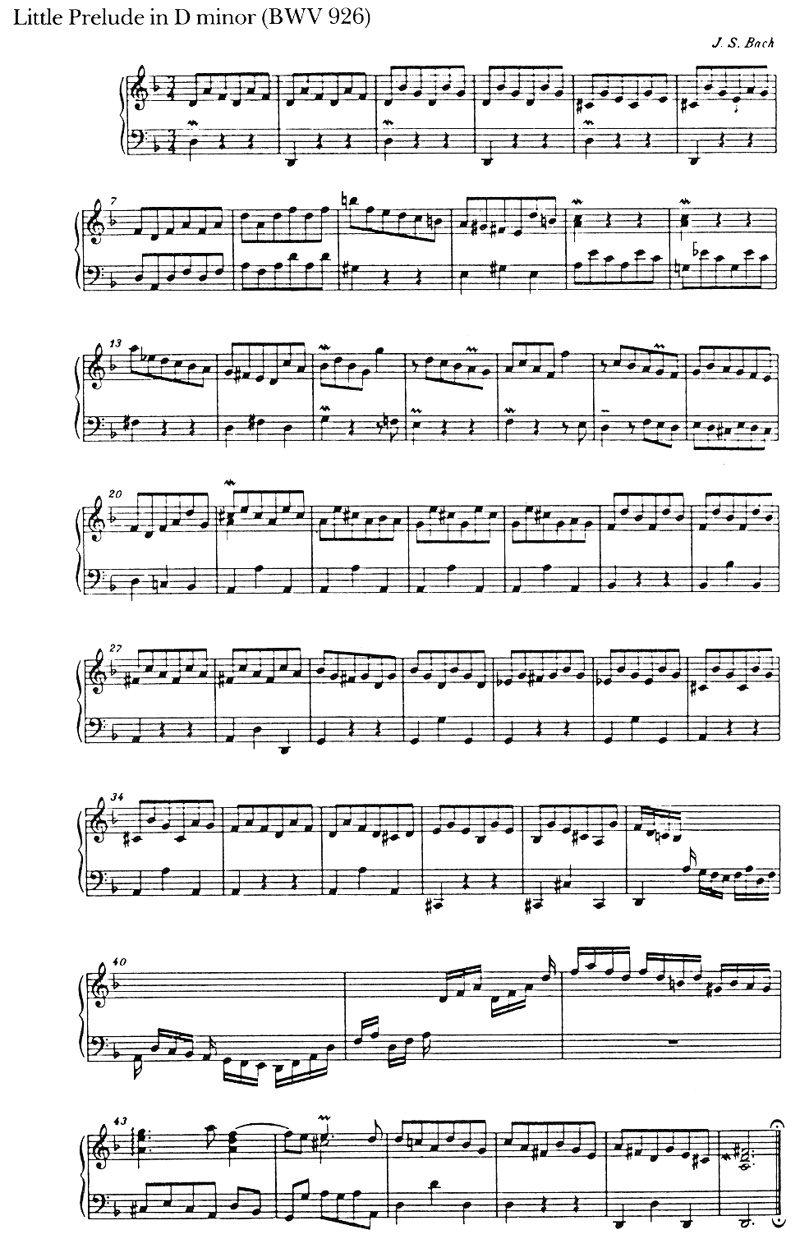
1The Stratification of Musical Rhythm (New Haven: Yale University Press, 1976), pp. 68-69.
2The Rhythmic Structure of Music (Chicago: University of Chicago Press, 1960), p. 42.
3The Denial of Death (New York: The Free Press, 1973), pp. x-xi; and Brown, Life Against Death: The Psychoanalytical Meaning of History (New York: Viking Books, 1959), p. 322.


